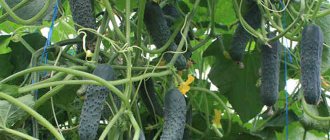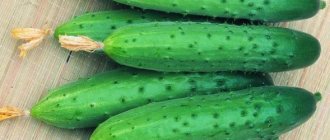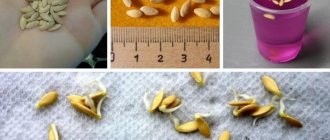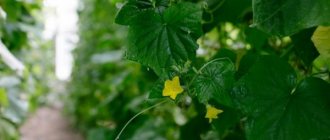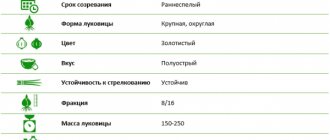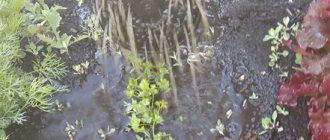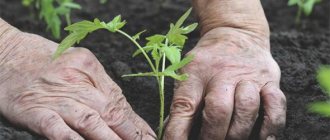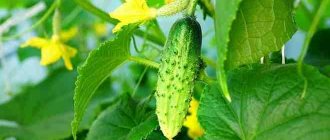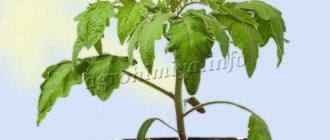Description of finger cucumbers
Cucumber Finger is a hybrid variety bred by Russian breeders in 2000, and entered into the State Register in 2001. Experts recommend growing this variety of crops not only in open soil, but also in a film cover. The Lower Volga, Central and Central Black Earth regions are recommended for cultivation.
In terms of ripening time, the variety Finger f1 belongs to the mid-season varieties, since the first fruits appear 40-50 days after the appearance of the first shoots.
Finger cucumbers differ from other varieties, for example, from the Connie variety, in that they have material for the next sowing. Vegetable growers also note the variety’s strong immunity and resistance to cold weather. Finger f1 cucumbers can withstand cold snaps of up to 4 degrees Celsius for 5 days. Finger cucumbers are versatile in use. Gherkins are used not only for preparing fresh salads, but also for pickling or preservation.
Characteristics of the variety:
- The bushes of the variety belong to the indeterminate type and reach a height of up to 2.5 m;
- The leaves of the plant are quite large and have a light green color;
- Description of the flowering variety: the female type of flowering predominates on cucumbers;
- Finger cucumbers reach a length of up to 15 cm;
- The peel of the fruit of the Palchik variety is thin, with large tubercles and small white spines, and has a dark green color;
- Description of the pulp: elastic, crispy, without voids, with a small number of seeds;
- Taste characteristics of cucumbers: sweet, aromatic, not bitter.
Description of fruits
Cucumbers of the Finger variety are one-dimensional, in the shape of an almost regular cylinder, weigh 114-120 g. The skin is almost smooth, there are few tubercles, but they are large. Cucumbers are dark green, with blurred spots and lighter stripes. The approximate length of the cucumber is 9.2-12.7 cm, thickness - 2.7-3.4 cm. Cucumbers really resemble fingers in some way. The pulp is dense, but very juicy, with a characteristic fresh aroma, crispy.
The purpose of the variety is universal. Finger cucumbers are good both fresh and homemade. During canning, the characteristic sweetish taste is preserved.
Even after heat treatment, salted and pickled cucumbers Finger have a wonderful crunch - for Russian gardeners this is an important factor
Pros and cons of the variety
Many vegetable growers and gardeners prefer the Palchik variety due to the list of its positive characteristics. As a rule, experts highlight the following description of the benefits of cucumbers.
pros
- Increased level of productivity of the variety (up to 10 kg of fruits are collected from 1 bush);
- Availability of seeds for the next sowing;
- Cucumbers are distinguished by long-term fruiting;
- Strong immunity to most diseases characteristic of the culture;
- Quite fast ripening of fruits;
- Variety resistance to cold conditions;
- Excellent taste characteristics of the variety;
- Cucumbers are versatile in use.
Minuses
Despite the fact that the breeders who worked on the creation of the Palchik variety claim that the variety has no drawbacks, growing experience suggests the opposite. As a disadvantage, vegetable growers note the overgrowth of fruits if they are not collected in a timely manner.
Advantages and disadvantages of the variety
Among the advantages of the variety, gardeners note the following:
- long fruiting period;
- excellent taste of the fruit;
- good presentation;
- resistance to spring and autumn frosts;
- immunity to many fungal diseases;
- resistance to downy mildew;
- high productivity;
- the variety does not lose its appearance during transportation.
Disadvantages of the variety:
- the need for timely harvesting;
- the need to pinch cucumbers;
- Bees are needed for pollination.
Landing Features
F1 cucumbers are planted in two ways: sowing (planting seeds in open soil) and seedlings (ready-made sprouts are planted in open soil). To get good fruits, you must follow the recommendations for planting cucumbers. Let's consider a description of all the rules for sowing cucumbers Finger f1.
Landing dates
In the regions of the middle zone, seeds are planted in the second half of May - the first half of June, and seedlings in mid-April. In the central regions, seed sowing is carried out depending on weather conditions and soil temperature. So, cucumbers are planted in open ground in the second half of April. It is also important to take into account the soil temperature: the ground should warm up to 15 degrees Celsius.
Site preparation
To plant the Palchik variety, choose a well-lit area, protected from drafts. It is recommended to take into account the predecessors of the crop: it is better to plant Finger f1 cucumbers after peppers, potatoes, tomatoes and cabbage.
They begin preparing the beds in the fall. The soil is carefully dug up and fed with mineral components: manure or compost.
In spring, the soil is watered with hot manganese liquid and dug up again. It is also recommended to remove all weeds. For depleted soil, it is recommended to feed it with wood ash, superphosphate or components containing potassium.
Planting seeds
Before planting, the seeds of Finger f1 are placed in a damp cloth and sent to a cool room for a day. This work is done to ensure that the seed develops faster. Afterwards the seeds need to be processed. To do this, they are placed in a manganese solution. Soak the seeds for 30 minutes.
To plant seeds for seedlings, use peat pots or disposable cups. Finger seeds are placed in a container up to 2 cm deep. After sowing, the cucumbers are watered with water at room temperature and placed in a warm room, the temperature of which reaches 20 degrees Celsius.
It is important not to exceed the recommended air temperature, since strong heat contributes to wilting and weakening of the bushes, as a result of which they will not tolerate transplantation into open soil.
Planting seedlings
Finger f1 seedlings are planted in open soil at the moment when about 5 leaves have formed on the sprout. Typically, this process takes about 30 days.
Finger cucumbers are planted in holes 5 cm deep. As a rule, bushes are planted to the bottom leaf. It is also important to take into account the soil temperature: the ground should warm up to 15-20 degrees Celsius. Before planting, it is recommended to sprinkle the holes with manure or compost.
Planting scheme
Cucumbers Finger f1 are planted at a distance of 30 cm between bushes and 50 cm between beds. This distance allows the bushes not to shade each other and not cling to their neighbors.
Characteristics
Finger - early ripening cucumbers that begin to bear fruit 40-45 days after transplanting the seedlings to the garden bed. If you plant the seeds immediately in open ground, the crop begins to ripen after 2 months or a little later. Fruiting is long lasting, lasting 8-10 weeks, ending in mid or late September.
Gardeners in those Russian regions where the climate is unpredictable, especially value Palchik cucumbers for their cold resistance. The bushes will survive temperatures up to 4 °C, lasting for 5 days. They are very likely to withstand both return frosts in the spring and the first frosts in the fall.
Finger cucumbers also tolerate drought relatively well. The characteristic bitterness of the fruit does not appear, even if you skip watering several times.
Another advantage of Finger cucumbers is their good resistance to fungal diseases. According to gardeners, they never suffer from downy mildew. Other diseases typical of cucumbers rarely develop with proper care.
The average yield is 6.8-7 kg per 1 m² or 2-3 kg per bush. Finger cucumbers should be collected regularly, once every 2-3 days. The greens quickly outgrow, turn yellow, and the flesh becomes soft and almost tasteless. The more often cucumbers are picked, the more actively new ovaries are formed.
Important! The Finger variety is valued by gardeners who grow cucumbers for sale not only for its presentability, but also for its good transportability, and a high percentage of marketable fruits (76-95%).
Advantages and disadvantages
The undoubted advantages of the Palchik cucumber variety include:
- ability to adapt to a wide range of climatic conditions (suitable for growing in different regions);
- predominantly female type of flowering of cucumbers;
- bunch type of ovaries;
- early ripening of cucumbers;
- long and stable fruiting (without “waves” of yield);
- presentable “appearance”;
- good taste and versatility of fruits;
- good cold and drought resistance;
- high immunity of cucumbers against most pathogenic fungi and absolute immunity to downy mildew;
Finger cucumbers also have disadvantages:
- pollination by bees only;
- the need to pinch cucumber vines and regularly remove stepsons;
- rapid overripening of cucumbers if you do not remove them from the bush in time.
In general, the Palchik cucumber variety has significantly more advantages than disadvantages. This is the reason for its stable popularity among gardeners, despite the ongoing “competition” from new breeding products.
Care
After planting the Palchik variety, the cucumbers need to be provided with proper care, since the yield of the crop and the taste characteristics of the fruit depend on these procedures. For care, it is recommended to systematically water the bushes, tie them up and shape them, as well as fertilize and hill up the soil. Let's consider the description of all agricultural work.
Watering
Cucumbers are a crop that loves moisture, but watering work is recommended to be done carefully, since excess moisture contributes to the rotting of the plant and the formation of fungi on it.
It is recommended to water Finger f1 cucumbers daily in the evening or early in the morning. The frequency of watering must be adjusted depending on the weather. If it rains, you need to water the plant less often. And during drought, watering can be increased to twice a day.
Water finger cucumbers with water at room temperature at the root. To do this, water is heated independently, or it is infused with sunlight.
On hot days, it is recommended to spray the leaves of the plant to prevent premature leaf fall or increase the period of fruiting.
Garter and bush formation
The Finger f1 variety has tall bushes, so they must be tied to pre-installed vertical trellises. This type of tying will greatly simplify harvesting and other agricultural processes.
If cucumbers are grown in greenhouse conditions, after the formation of 4 true leaves, the main vine of the plant is pinched over the trellis.
Top dressing
During the entire growing season, Finger f1 cucumbers need several feedings in sunny weather. Let's look at the description of fertilizing schemes.
The first and mandatory fertilizing of the variety is carried out 14 days after the sprouts appear, or after transplanting the seedlings into the soil. The bushes are fed with fertilizers containing nitrogen and potassium, which help the bushes to grow stronger and grow leaves.
The second feeding is carried out at the moment when the bushes begin to bloom. Finger cucumbers f1 are fed with minerals containing phosphorus.
The following feedings are carried out only if necessary: if there is a violation of the thermal regime, the plant is fed with phosphorus, iron, or potassium, and also when fruits are slowly forming (the plants are fed with a mixture of mullein, urea, or humus).
Hilling
Hilling cucumbers is strictly prohibited. This is due to the fact that the roots of the plant spread along the ground surface, and when hilling, the root system of the plant can be damaged. As a result, the cucumbers will begin to wither and die.
However, experienced gardeners advise loosening the beds using a pitchfork. Loosening is carried out after watering. This care process helps remove the hardened layer of soil, which does not allow the required amount of oxygen and moisture to reach the plant’s root system. In addition, loosening helps remove weeds.
Description of the variety
The Russian variety “Palchik” belongs to the group of bee-pollinated and early-ripening varieties. Universal purpose allows you to use the harvested crop without restrictions. The taste is very high. Fruiting occurs 42-46 days after planting in a permanent place.
The plant is disease-resistant and practically not susceptible to downy mildew. Cucumber bushes have increased cold resistance and can easily tolerate slight drops in temperature in the spring, as well as early autumn cold.
The length of the elongated cylindrical green is on average 11 cm. The surface has a fairly sparse and large tuberculation. The pulp of ripe greens is very dense, juicy, with a pronounced crunch and a bright aroma. The average weight of greens is 117 g.
Diseases and parasites
Despite the variety’s strong immunity to most cucumber diseases, Finger f1 cucumbers are still susceptible to diseases such as root rot, bacteriosis and mosaic. Let's consider a description of all the listed diseases and ways to combat them.
Root rot
Root rot is an infection that affects a plant after it is transplanted. When affected by root rot, the plant wilts, the stem becomes thinner, and cracks form. Darkening of the root system of the plant, its softening and yellowing of the leaves are also observed. To combat root rot, chemical preparations “Alirin-B”, “Previkur” and “Gamair” are used.
Bacteriosis
Bacteriosis is a disease that results in a slowdown in plant development, deterioration in leaf assimilation and decreased fruit formation. Brown spots also form on the leaves, which soon acquire an oily consistency. To combat bacteriosis, the substances “Champion” and “Kuproksat” are used.
Mosaic
Mosaic is an infection that appears during the growing of plant seedlings. With mosaic, there is the formation of small warts on the leaves, a decrease in the number of leaves, a significant decrease in the number of flowers and shortening of internodes. To combat mosaic, it is recommended to use chemical preparations “Aktara”, “Aktellik”, as well as Burgundy liquid.
Cucumber Thumb is our green favorite
Nowadays you won’t surprise anyone with new hybrids of cucumbers with attractive names. More than a thousand of them are registered in the State Register of Selection Achievements. But gardeners still give preference to proven, well-known cucumbers, among which is Little Thumb. This hybrid, which has many advantages, has faithfully served lovers of crispy green vegetables for almost two decades. And it's not just the fabulous name. He's really good.
What will make a little boy happy?
The authorship of the hybrid belongs to the seed breeding industry, which has given gardeners many interesting and high-quality varieties and hybrids, and not only cucumbers. In this regard, it would be useful to recall: the key to a rich harvest is purchasing seeds from the manufacturer or its representatives, but in no case from random sellers in spontaneous markets.
By purchasing seeds from reliable suppliers (for example, “Manul”), you are guaranteed to provide yourself with a good harvest
Since we are specifically interested in the Boy Thumb F1 cucumber, let’s consider its positive and negative sides. Those who are familiar with the F1 designation know that plants of this type have much more advantages than disadvantages. Boy Thumb is a heterotic hybrid, that is, a plant obtained by crossing two different varieties with the desired characteristics.
The letter “F” is abbreviated as “Filli”, that is, “offspring”, and the number “1” indicates that we are offered the first generation, which has the best and most clearly manifested positive qualities of both “parents”.
“Heterosis” is translated from Greek as “improvement.” Unfortunately, it only appears in the first generation, so seeds from F1 hybrids are not collected, otherwise you can get a harvest of deformed, tasteless fruits.
But high-quality varietal seeds of the Thumb-sized cucumber, purchased in specialized stores, will delight you with the following advantages:
- wide regionalization - Little Thumb has successfully passed tests and is recommended for cultivation in all regions of Russia. True, the State Register of Breeding Achievements makes a reservation: the hybrid should be grown under film covers. But practice shows: these cucumbers feel great in the open ground of the southern and central regions of Russia. Naturally, this does not cancel more frequent watering in the arid south and temporary shelters when there is a threat of frost in regions with a harsh climate;
- parthenocarpy is another foreign word that denotes a very useful property: the ability of a plant to form fruits without pollination; that is, the hybrid is not self-pollinating, as is sometimes written about it, but is self-fertile;
Cucumbers of the Boy Thumb variety are capable of producing fruits without pollination - very good quality for greenhouses
Thanks to the bouquet (3-4 in a bunch) type of ovary, gherkin cucumber varieties have high yields
Perhaps the only drawback of the Little Thumb hybrid is that it is not resistant to downy mildew. Since this is an early ripening cucumber, it is better to fight powdery mildew not with chemicals, but with environmentally friendly means, in order to have exceptionally healthy gherkins for the table.
Among the folk recipes you will find useful:
- milk solution (1 liter per bucket of water) with the addition of 1 teaspoon of copper sulfate;
- whey solution (2 liters for the same amount of water) also with the addition of 1 teaspoon of copper sulfate. Vitriol can be replaced with 10 ml of brilliant green or 30 drops of iodine.
Milk, iodine and brilliant green will help in the fight against diseases of the Boy with a Thumb cucumber variety
Growing a hybrid Boy with a Thumb
These wonderful cucumbers in many ways do not require special care. But some general requirements must be followed if you want to get a decent harvest. Since we are dealing with a heterotic hybrid, and also a parthenocarpic, it is necessary to know not only what should be done, but also what is not necessary or impractical.
Seed processing and planting
Many hybrid seeds are sold in the original packaging from the manufacturer (usually it has a thin layer of foil inside). This type of packaging is the best, as it additionally protects the planting material from changes in humidity and temperature during storage. If you purchased seeds in paper packaging, then you can increase their resistance to disease and reduce the risk of poor harvests due to improper storage in a warehouse by heating them (dry, in a bag) near a radiator for three to four weeks. This does not require any costs, but the effect is positive.
Apart from heating, dry seeds of cucumber hybrids do not require other types of processing. They do not need to be disinfected, checked for germination, or selected to contain full-strength salts in solution, as is the case with your own seeds. For F1 hybrids, these procedures at home are unnecessary: the material has already been treated against diseases, as well as growth stimulants. The manufacturer takes care of this.
To wait for germination as quickly as possible, the seeds can be “awakened”: kept in a humid environment with access to air for three to four days, preferably in damp gauze or cloth (but not cotton wool) in a sealed container next to heating devices. You should not overexpose the seed: the seeds may sprout too long, and it will become more difficult to sow them. A seed with a broken sprout may die.
Germinate cucumber seeds in damp cloth for no more than three to four days.
It is not recommended to germinate coated (encrusted) seeds. Nothing bad will happen to them, but you will simply destroy the results of painstaking work, thanks to which agents to combat a whole range of diseases and pests, as well as useful substances and growth stimulants, are applied to the surface of the seed. Such “colored” seeds should be sown dry, but immediately after sowing, cover the wet bed with film and do not remove it until the sprouts appear. Sprouted seeds also need a lot of moisture.
It is not recommended to soak inlaid cucumber seeds, but it is necessary to keep the soil moist until full germination appears.
But now you have purchased quality seeds. What is the best way to sow them? The process looks like this:
- We choose a place. The best predecessors of cucumbers are tomatoes, onions, and cabbage. You should not sow Thumbnail after pumpkins (zucchini, squash, pumpkin).
- We disinfect the future bed in the fall. To do this, generously spray the soil with a solution of copper sulfate (a tablespoon per bucket of water). This should be done no more than once every four to five years, but this method of combating pathogens overwintering in the soil should not be ignored; it is very effective and significantly improves the condition of plants. It is especially important to carry out this disinfection if the predecessor of the cucumber was a tomato.
Cucumber beds should be treated with copper sulfate solution every four to five years.
Planting cucumbers in holes gives the plants enough space to grow and develop.
Water the sown cucumber seeds using a fine-mesh watering can so that the soil remains soft
Thinning of hybrid crops The size of a boy is not done. The seeds are quite expensive, germination is 95–98%. That’s why they are not sown thickly. If your seeds germinate poorly, change the seller.
Care during the growing season
Cucumbers of this type are easy to care for. It is required to carry out general agrotechnical measures:
- watering - it is especially important in greenhouses where rain does not penetrate, and during mass fruit setting. Plants should be watered once every three to four days, using at least 3 liters of water for each bush. Watering can be combined with fertilizing with ash (two handfuls per bucket). If you cannot water your cucumbers often, you can ease their condition in hot weather by sprinkling the leaves with water. This should be done early in the morning or late in the evening;
- Loosening and weeding should be done after watering, because cucumbers benefit from adding moist soil to the base of the stem - it stimulates the formation of additional roots. Careful removal of weeds will not only give the plantings a beautiful, well-groomed appearance, but will also serve as an excellent disease prevention.
Only in a weed-free bed will healthy and strong cucumber bushes grow.
If the summer is rainy, watering is not carried out, but loosening is necessary, but wait until the soil dries out slightly. By covering the plants with too wet, heavy soil, you will impede air access to the roots.
Mulched cucumber plantings give the gardener less trouble
Features of growing cucumbers in a greenhouse
Hybrid Little Boy feels great in unheated and heated greenhouses, as well as in warm beds. It is very simple to equip the latter by adding biofuel under a 25–30 cm layer of soil in a layer of up to 40 cm (straw, manure).
When growing cucumbers indoors, you should consider the following points:
- Using seedlings will help you get super early harvests. Since cucumbers do not tolerate transplantation very well, their roots are not disturbed. Seedlings are grown in peat pots, as well as homemade containers made of newsprint or in eggshells, planted in the ground with containers;
- high humidity (about 80%) promotes better plant development;
- cucumbers in a greenhouse need a high level of carbon dioxide in the air. You can ensure a sufficient amount of it by properly fertilizing the soil with manure;
- uniform distribution of vines along the trellises will help the plants receive more sunlight, which will also have a positive effect on their development and productivity. Tie the vines to the supports in a timely manner, do not allow the plants to cross or shade each other.
Cucumbers of the Thumb-sized variety form side shoots less often, and they are shorter than those of conventional varieties, which is convenient in the tight space of a greenhouse
Thumb boy at your house
Another wonderful property of this hybrid is the ability to grow and bear fruit beautifully on windows and warm balconies of apartments. You can get a good vitamin supplement to your diet as early as the end of February if you follow these tips:
- spare no space for your cucumbers. Plant one plant in a five to six liter container. Thickening plantings will only reduce the yield;
- use light soil mixtures (garden soil + peat + humus) or buy ready-made ones. The cucumbers will thank you;
- arrange additional lighting on cloudy days. Cucumbers need a 12-hour “light” period during the day. Fluorescent lamps are a great option;
- Do not feed indoor cucumbers with mineral fertilizers, as a small volume of soil can lead to an increased concentration of undesirable substances in the fruits. It is better to use tincture of banana peel, ash, yeast, and bread as fertilizer;
- at least once every 10 days, spray the garden on the window with a bright pink solution of potassium permanganate. In the absence of natural air exchange, destructive viruses and bacteria actively develop in the soil.
Cucumbers of the Boy-sized-thumb variety can be successfully grown on a windowsill
Reviews of the hybrid Boy with a Thumb
The name of these cucumbers speaks for itself, they really grow exactly this size and are very tasty and crunchy, of course, if the seeds are purchased F1, because the cucumbers are hybrid and you won’t be able to plant the collected seeds, there just won’t be the same effect, but They may not bear fruit at all... So only purchased seeds are suitable, and always branded ones.
xzbt12
https://otzovik.com/review_4848549.html
My Little Thumb has surpassed everyone’s vaunted Herman in terms of productivity. Liana grew over two meters in the greenhouse. Still growing. I will definitely plant more next year!
ArtelkaMama
https://www.asienda.ru/post/21909/
I soak the first cucumbers around April 5th; they begin to bear fruit in the last days of May. Last year I was very pleased with Thumb. Before the first street cucumbers, they devoured them for their dear soul. True, then, as always, the street ones crowd them out, the taste still cannot be compared. But, I want to say: Thumb is one of the few that was almost as good in taste. And - SMALL!
Alena Latvia
https://dacha.wcb.ru/index.php?showtopic=39538&st=700
To get a harvest of delicious, crispy gherkins in a greenhouse and open ground in the summer, on a window in late winter, and even cucumbers that are good pickled, fresh, or pickled... This is impossible, you say? Plant the hybrid Thumb and make sure that gardeners all over the country rightfully give it preference.
Harvesting and storage
It is recommended to collect the variety Finger f1 every day. This procedure is carried out so that the formed fruits do not interfere with the development of new ones.
The fruits of the Palchik variety must be stored in a room whose temperature does not exceed 4 degrees Celsius: in the basement or in the cellar. If cucumbers are intended for fresh use, they are placed in the refrigerator, where they will remain for about 7 days without loss of appearance and taste.
To prevent cucumbers from rotting, they are placed in boxes. Such containers allow the necessary amount of oxygen to pass to the fruits. If any cucumber begins to rot, it must be removed immediately. It is also necessary to remove cucumbers that came into contact with the rotting vegetable, since they could have become infected.
Planting seedlings in open ground
As soon as the warm weather has arrived and all the frosts are behind you, you can begin to transplant the seedlings into open ground.
The best period for this is the end of May. However, nights can be cool and therefore additional protection for young cucumbers should not be neglected.
To begin with, you can cover the plants with film. As soon as the night temperature has settled and no longer threatens frost, the secondary cover can be removed and cucumbers can be grown on a trellis.
Caring for cucumbers is not difficult, the main requirements are:
- Regular watering with warm water
- Formation of plants
- Loosening the soil
- Weed removal
- The distance between the bushes is about 30 cm, and between the rows about 60 cm.
- The most intensive watering is provided in hot weather, as well as during flowering and fruit set.
- Before planting, you can add a little manure or compost into the prepared trenches, which are sprinkled with another layer of earth. After the seedlings are placed in the hole, they should be carefully sprinkled with soil and pressed with your hands.
- To prevent moisture from evaporating so quickly on a hot day, the roots of the cucumber can be mulched with dry grass or straw.
- As soon as the cucumber grows, it is tied to a trellis along which the seedlings will climb.
There are no difficulties in planting cucumbers of the Palchik variety. However, in order to get a rich, tasty harvest, you need to follow certain care rules.
More information can be found in the video.
A productive and easy-to-care variety of cucumbers “Palchiki” with excellent tasty fruits
Farmers love finger cucumbers for their taste without bitterness, ease of care and the shape of the fruit, suitable for preparations and fresh dishes. Its early ripening and uniform fruiting will allow even a small plot to have a good harvest all summer. In this article we will tell you in detail about the advantages and specifics of growing Finger cucumbers.
Description of the variety
Finger cucumbers are an early ripening variety. It is resistant to diseases and low temperatures, suitable for open ground and greenhouses. It is characterized by uniform fruiting, which lasts for two months.
The variety was bred for open ground, so to grow cucumbers in a greenhouse, a fan is placed there during flowering or a beehive is brought in. The beehive solution is suitable for cultivating vegetables in winter in large greenhouses. Insects are used at the rate of one family per thousand meters.
Distinctive features
This is a bee-pollinated cucumber variety . The plant has female flowers. Unlike other cucumbers, Fingers have almost no thorns on the fruit. They cannot be left on the bushes for a long time, as they become overripe and lose their taste and presentation.
Composition, properties, benefits, calorie content
When consumed in moderation, cucumbers are beneficial. In addition to water (95%), the composition includes potassium (141 mg per 100 g), iodine, calcium (23 mg per 100 g), magnesium (14 mg per 100 g) necessary for heart function and other minerals, vitamins A, C , RR, group B and others.
Due to the large amount of fiber, cucumbers help quickly remove toxins from the body and improve intestinal motility. Their low calorie content makes them an ideal dietary food. 100 g of cucumber contains only 10-15 kcal.
Characteristics
The height of the bushes reaches 2-2.5 m. The plant forms strong and thick lashes. The fruits are dark green in color and have a slightly tuberculate surface without spines. They taste sweet and crunchy, without bitterness. The maximum length of the greens is 12 cm, weight – about 130 g.
The fruiting period is two months. 40-45 days after planting the seedlings in open ground, you can already collect the first “fingers”. If agricultural practices are followed, one bush produces about 7 kg of cucumbers.
How to grow a variety yourself
The Fingers variety is easy to grow. Caring for it is no different from caring for other varieties of cucumbers. Plants need to be regularly watered with a small amount of water, fertilized and provided with a comfortable air temperature. After heavy rain and each watering, the soil is loosened.
Important ! Experienced gardeners recommend shaping plants. To do this, pinch the main vine of the bush above the trellis when growing in a greenhouse.
Planting by seeds and seedlings
The variety Fingers is grown both by seed and seedlings. If you choose the first method, then pay attention to the air temperature - it should not be lower than +15 °C. It is advisable to warm and soak the seeds. They are planted in the beds in mid-May. Before sowing, the bed is cleared of weeds, loosened and fertilized with fresh manure. Seeds are placed in the soil to a depth of 2-3 cm.
Attention! If you soak the seeds in a damp cloth for several days, they will sprout several days earlier than dry ones.
You can buy the substrate ready-made or make it yourself:
- turf soil - 4 parts;
- lowland peat – 4 parts;
- manure - one part;
- sawdust - one part.
Place the seeds in shallow longitudinal holes and cover them lightly with soil. Fertilizers are applied to nourish the soil. For 10 liters of soil you will need:
- urea – 6 g;
- superphosphate – 14 g;
- potassium sulfate – 8 g;
- magnesium sulfate – 2 g.
Growing in stages and care
Before the first shoots appear in open ground, the bed is covered with film.
Containers with seedlings are covered with polyethylene and taken to a room with a temperature of about +25 °C. After the first leaves appear, the room temperature is lowered by 5 °C. Seedlings need to be provided with lighting, a temperature of +20...23 °C, regular watering and nutritional supplements.
When the sprouts reach 25 cm in height and five true leaves form on the stem, the seedlings are transferred to open ground. Plants are planted according to a pattern of 50 cm by 30 cm.
During the period of mass flowering of cucumbers, phosphorus fertilizers are used for fertilizing; during the active growing season, nitrogen-potassium fertilizers are used.
Cucumbers of this variety need regular and careful watering. Overmoistening of the soil is fraught with the appearance of fungal diseases and rotting of the roots. Early in the morning, before sunrise, the bushes are watered at the roots with warm water. To do this, use water that has stood under the sun's rays.
Important! Cold water is not suitable for irrigation. It can cause massive shedding of ovaries and cause a poor harvest.
Features of cultivation and possible difficulties
This variety likes to grow in well-drained soils. The area is first cleared of the remains of plants that grew on it before.
It should be borne in mind that the rate of seed germination in the ground depends on their position. Place the seeds with the spout facing up at a 45 degree angle. This will help the sprouts quickly get rid of the seed coat and grow upward. In this case, the root system of the cucumber will form parallel to the ground and go deep.
Important! The variety is grown on vertical trellises and care is taken for pollination by insects.
Greenhouses with cucumbers are well ventilated so as not to disturb the thermal regime, and foliar fertilizing is applied.
Diseases and pests
The variety has good immunity to diseases. Plants practically do not suffer from downy mildew, but are often attacked by mites and aphids. To avoid this, plants are treated with copper sulfate or soap solution for prevention. Slugs and parasites on the roots of bushes are destroyed using ash or ash flour, which is applied directly to the soil.
To get rid of aphids, do the following: leave 400 g of shag in a bucket of water for two days, then add 80 g of soap. Black aphids on cucumbers will disappear with this treatment. You can also get rid of it with the help of ladybugs: you can buy larvae or collect the insects yourself.
The destruction of spider mites is guaranteed by insectoacaricides (Aktellik, Fitoverm) and acaricides (Neoron).
Harvesting and application
It is not recommended to leave ripe cucumbers on the bushes for a long time.
Reference. Ripe fruits that hang on the vine for a long time become overripe and become yellow and watery.
The Fingers variety is often used for pickles or pickling. After heat treatment, cucumbers of this variety do not lose their crunch. Fresh cucumbers are suitable for various dishes - for example, salads, okroshka, sandwiches.
Advantages and disadvantages of the variety
Among the advantages of the variety, gardeners note the following:
- long fruiting period;
- excellent taste of the fruit;
- good presentation;
- resistance to spring and autumn frosts;
- immunity to many fungal diseases;
- resistance to downy mildew;
- high productivity;
- the variety does not lose its appearance during transportation.
Disadvantages of the variety:
- the need for timely harvesting;
- the need to pinch cucumbers;
- Bees are needed for pollination.
Reviews
On the Internet there are many positive reviews about the Fingers variety, which confirm its characteristics.
Maria, Minsk: “This year I purchased “Palchiki” cucumber seeds. I planted them in open ground at the beginning of May, but covered them with white covering material, and removed them at the end of May. The seeds sprouted together. They grew and were pleasing to the eye. Interestingly, my cucumbers were exactly like in the picture. At one time I was away for a long time, we went on vacation, and upon arrival my cucumbers did not grow much, or rather they grew, but only in length and at the same time did not lose their attractive appearance, did not get fat or turn yellow. I used them to make a fresh salad.”
Tanya, Tyumen: “The variety doesn’t overgrow too much - that’s its beauty. Cucumbers with thin, rather prickly spines hold tightly to the branches, so I cut them off with scissors. The taste is good! The fruits are tender, juicy, and sweetish. I didn't eat bitters. The skin is thin."
Olga, Vitebsk: “Last year I tried a new variety of cucumbers, Fingers. I planted seedlings. Almost all the seeds sprouted perfectly. This certainly made me happy. I planted the seedlings in open ground. The cucumbers grew one to one. Handsome guys - strong, small. Crispy, the core is not watery, without bitterness. Towards the end of summer, I began to pickle the harvest. The cucumbers are small in size and fit perfectly in a liter jar. I took my simplest recipe. Cucumbers delighted the family not only in summer, but also in winter.”
Conclusion
The Fingers variety is attractive due to its excellent taste and high resistance to diseases and cold. Cucumbers ripen early and bear fruit well. Crispy and juicy fruits are suitable for fresh consumption and as part of various dishes. By following the simple rules of agricultural technology, you will certainly be able to get a wonderful harvest - one that will lick your fingers!
